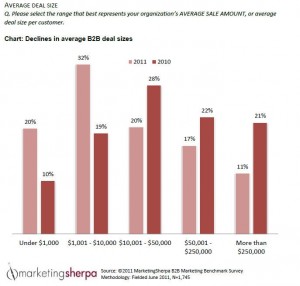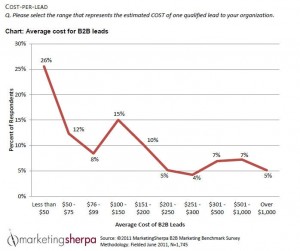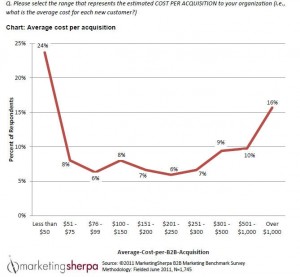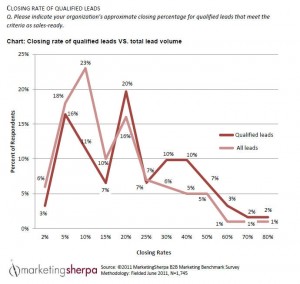B2B Marketing: Combating a shrinking deal size
Every time I look through the new 2012 B2B Marketing Benchmark Report, I find something interesting or useful from this research based on 1,745 surveyed marketers.
A B2B marketing challenge
Yesterday, I actually came across a chart I find disturbing:
Hopefully your deals aren’t moving to the left side of this chart. As you can see, compared to last year, the average B2B deal is declining. Deals under $10,000 have increased (with deals under $1,000 up 100%), and all deals over $10,001 are down.
Similar to the data point that the smallest deals are increasing the most, the largest deals – over $250,000 – are down by the largest percentage.
Yikes.
Part of this is likely attributed to the ongoing economic difficulties. Some larger B2B purchases are perhaps being put off until the financial outlook is better. Although, our research found one reason for this decline: the economy is causing B2B companies to feel pressure to accelerate their current pipeline and get deals closed.
The problem with this strategic response is that now B2B companies are competing on price instead of value and are offering promotions that result in overall smaller deal sizes as well as including fewer products and services in the deal so it’s a simpler sale.
Another data point from the report also supports this research – compared to 2010, the average length of sales cycles in 2011 was much shorter.
Comparing 2011 to 2010, cycles of:
- Less than one month, up 15%
- One to three months, up 4%
- Four to six months, down 2%
- Seven to 12 months, down 7%
- Over one year, even
One common reason for a shortened sales cycle is the deal becomes less complex. For example, Sales might work harder to close multiple one-year licenses to meet their quota instead of taking the time to nail down the all-you-can-eat enterprise license agreement.
Solving the declining deal size issue
Competing on price over quality while selling smaller deals with less products and services is not a long-term solution to the problem of declining deal sizes. At some point, margins become too small while the cost of marketing to the complex sale (and a simpler B2B sale is still a complex sale), even if the cycle is shortened, isn’t going to dramatically change.
What is a long-term strategy that addresses the issue? Funnel optimization. This means looking at every aspect of the pipeline from lead capture and generation all the way through to the handoff to Sales.
When the entire funnel is continually optimized, you can still accelerate the pipeline. But instead of Sales rushing to turn the existing pipeline into closed deals, with Marketing consistently bringing in new leads, nurturing those leads and regularly handing Sales leads that have been scored and are qualified, Sales is more confident of having a sustainable supply to help it meet its quotas.
These are leads who are qualified for your offer and who don’t require promotional pricing gimmicks to become paying customers.
Three charts on optimizing leads
These next three charts offer very simple illustrations of the benefit of optimizing leads through the funnel.
First, here is the average cost for B2B leads:
You can see the average cost for B2B leads is heavily skewed toward less expensive leads. It’s important to remember that simply keeping lead cost down is not an effective key performance indicator to look at in isolation.
Sometimes, cheap leads can be expensive in the long run.
Take a look at this chart:
Notice the U-shape of this chart. Where the average cost-per-lead was weighted toward cheaper leads, the average cost-per-acquisition, which is the cost for each actual customer, does not show as clear of a trend. Sure, there are plenty of those cheap leads converting for under $50. But, at the same time, the next highest data point shows a CPA of over $1,000.
Clearly some of those “cheap” leads end up costing quite a bit before becoming customers.
Optimizing the top-of-the funnel lead gen might possibly increase some of those upfront costs, but often the benefit will appear in the cost-per-acquisition KPI.
And how about optimizing those leads after capture, but before the handoff to Sales? Here is where lead scoring and qualifying show their value.
This chart shows how qualifying leads improves closing rates:
Remember, the lighter-colored line represents all leads, not only unqualified leads, and the darker line represents qualified leads. As you can see, when you get past the 25% closing rate point, qualified leads outperform all leads.
The takeaway from this series of charts is declining deal size is not a trivial issue facing B2B marketers, but if you are willing to put real effort into optimizing the entire funnel, it is possible to both accelerate the pipeline and keep it filled with valuable leads.
Don’t get me wrong. Funnel optimization is not a simple process. It requires time and effort paying serious attention to every part of the sales cycle.
If you can hand Sales qualified leads, your company won’t be as compelled to begin competing on price rather than value. And that’s something that should make the B2B marketer facing another challenging 2012 smile.
Related Resources:
MarketingSherpa’s 2012 B2B Marketing Benchmark Report
Email Marketing: Triggered emails that target the conversion funnel boost revenue
Marketing Research Chart: Most challenging Marketing-Sales funnel processes
B2B Marketing: How good data can solve big problems
Funnel Optimization: Why marketers must embrace change
B2B Tactics: Maximizing marketing efforts in a tough economy
Marketing Funnel: How to optimize your Sales and Marketing funnel in 5 steps
Test Plan: Build better marketing tests with the Metrics Pyramid
Categories: B2B Marketing 2012 B2B Marketing Benchmark Report, B2B marketing, deal, deal size, funnel optimization, lead, sales cycle













